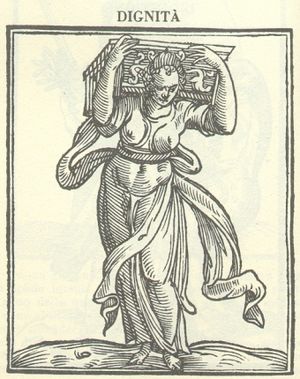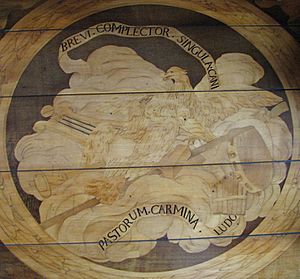Cesare Ripa facts for kids
Quick facts for kids
Cesare Ripa
|
|
|---|---|
Portrait of Cesare Ripa in Della novissima iconologia di Cesare Ripa perugino (1624)
|
|
| Born | 1555 |
| Died | 22 January 1622 (aged 66–67) |
| Nationality | Italian |
| Occupation | Iconographer and scholar |
| Known for | Iconologia overo Descrittione dell’imagini universali cavate dall’antichità et da altri luoghi (1593) |
| Academic background | |
| Influences | Prudentius, Martianus Capella, Domenico Nani Mirabelli, Francesco Colonna, Andrea Alciato, Paolo Giovio, Achille Bocchi, Pierio Valeriano Bolzani, Giglio Gregorio Giraldi, Natalis Comes, Vincenzo Cartari |
| Academic work | |
| Influenced | Pietro da Cortona, Gerard de Lairesse, Willem van Mieris, Vermeer, Vondel, Artus Quellinus, Antonio Cavallucci, Winckelmann, George Richardson, Piero Buscaroli |
Cesare Ripa (born around 1555 in Perugia, died January 22, 1622, in Rome) was an Italian writer and scholar. He was known for his important book, Iconologia. He worked for a powerful church leader, Cardinal Anton Maria Salviati, as a cook and butler.
Contents
Life of Cesare Ripa
Not much is known about Cesare Ripa's early life. He was born into a simple family in Perugia around 1555. The exact date of his birth is not known.
Early Career and Education
When he was young, Ripa moved to Rome. He started working for Cardinal Antonio Maria Salviati. Ripa was very active in scholarly groups. These groups studied old writings from Greek and Roman times. He also joined the Accademia di San Luca, an art academy. Here, he likely met important thinkers and artists of his time.
Publishing Iconologia
In 1593, Ripa published the first version of his famous book, Iconologia. This first edition did not have any pictures. The book became very popular. It was printed many times and translated into other languages. In 1598, Pope Clement VIII honored Ripa. He made him a knight of the Ordine dei Santi Maurizio e Lazzaro.
Cesare Ripa's Iconologia

The Iconologia was a very important emblem book. It showed how to represent ideas using symbols and pictures. Many of these ideas came from ancient Egyptian, Greek, and Roman art. The book was full of personifications. This means giving human qualities or forms to abstract ideas. For example, "Justice" might be shown as a woman holding scales.
Purpose of the Book
Artists, writers, and speakers used this book a lot. It helped them show ideas like virtue (goodness), vice (badness), emotions, arts, and sciences. Ripa's book helped them create clear and understandable symbols.
How the Book Was Organized
The ideas in Iconologia were listed in alphabetical order. For each idea, Ripa gave a detailed description. He explained how to draw or sculpt the figure. He described their clothes, colors, and the objects they held. He also explained why these symbols were chosen. Often, he referred to old stories and writings to support his choices.
Influence of Iconologia
The first edition of Iconologia came out in 1593 without pictures. A second edition was published in Rome in 1603. This one had 684 ideas and 151 woodcut illustrations. It was dedicated to Lorenzo Salviati. The book was later translated into French in 1636 by Jean Baudoin.
Impact on Art and Culture
Ripa's book was extremely influential in the 17th and 18th centuries. Many artists used it as a guide.
- The painter Pietro da Cortona and his students were greatly influenced by it.
- Dutch painters like Gerard de Lairesse and Willem van Mieris based their art on Ripa's symbols.
- Vermeer used Ripa's ideas in his famous paintings. For example, he used the symbol for the muse Clio in The Art of Painting. He also used several symbols in his painting The Allegory of Faith.
- The Dutch writer Vondel's works are better understood with Ripa's book.
- The sculptor Artus Quellinus used Ripa's ideas for the decorations at the Amsterdam town hall.
- An English translation of the book appeared in 1709 by Pierce Tempest.
Later Influence and Criticism
The baroque painter Antonio Cavallucci used Iconologia for his painting Origin of Music. In 1779, the Scottish architect George Richardson published his own version in London. It was called Iconology. This book had 424 subjects and showed the beauty of good actions and the ugliness of bad ones.
Many versions of Iconologia were published across Europe. But in the mid-1700s, the book became less popular. A scholar named Winckelmann strongly criticized Ripa's work. He said that only a few of Ripa's ideas were good. Because of this, Ripa's Iconologia was not studied much for a long time. However, recently, scholars have started to realize how important Ripa's book truly was.
See also
 In Spanish: Cesare Ripa para niños
In Spanish: Cesare Ripa para niños
- Andrea Alciato
- Pierio Valeriano Bolzani


